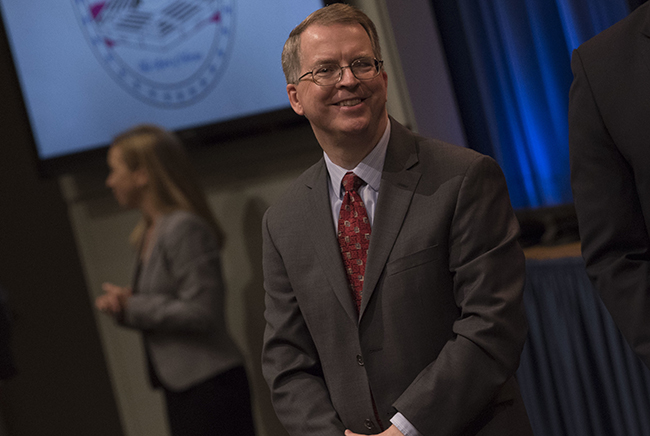
Acting Deputy Defense Secretary David Norquist, shown here at the Pentagon on May 9, 2019, spoke on the need for increased Defense Department research and development investment during a May 30, 2019, event at the Center for a New American Security in Washington. DOD photo by Lisa Ferdinando.
The Pentagon consciously decided to funnel more money into research and development rather than grow the military in the short term in the 2020 budget request, acting Deputy Defense Secretary David Norquist said May 30 at the Center for a New American Security.
Being able to meet challenges across domains is more important than manpower growth, Norquist said, while backing the Air Force’s plans to build up to 386 squadrons and a 355-ship Navy.
Susanna Blume, the deputy director of CNAS’s defense program who led a discussion with Norquist at the Washington think tank, has called the Pentagon’s focus on numbers of platforms misguided and potentially unachievable even if annual defense spending sits around $750 billion as DOD wants next year.
She argues DOD and Congress need to look at more qualitative measures instead of basing its decisions on more squadrons or more of a particular weapon system.
Numeric targets “bias program decisions in favor of numbers of platforms at the expense of the kinds of things that make those platforms lethal—advanced munitions, electronic warfare capability, and training for the sailors and airmen that man them,” Blume wrote in a May 22 post. “The result can be a military that has more force structure than it can afford to keep modernized and ready, in other words, a hollow force.”
She noted that former Defense Secretary Jim Mattis’ push for new capabilities seems to contrast with how the services approach their future plans.
“That was sort of music to [the] ears of those of us who were around in the late Obama administration Department of Defense as we were pushing hard in the same direction,” Blume said of Mattis at the May 30 event. “And yet, so much of what we hear coming out of the services … seems to be focused on numbers instead of the qualitative measures of what the force is able to do.”
Norquist suggested the 2020 request does pursue technology advances in artificial intelligence, autonomy, directed-energy, hypersonic weapons, and more to ensure that when the military does achieve its force structure goals, it will have the appropriate tools to wield in modern combat.
“One of the challenges with the size of the force as an issue in terms of driving things is, you need to make sure you can sustain it,” Norquist said. “What we have worked hard [on] with our recovery is to avoid having a hollow force. You don’t want to build up a force structure that you can’t sustain the maintenance, the spare parts, the training, those other operations.”
Most growth within the services will be aimed at filling out existing units or expanding certain areas like space and cyber that are needed more in the 21st century, he continued.
“Until you have real certainty in the long-term budget, you can easily increase the size of the force, only to have to walk it back three years later, and that’s a whole bunch of money that didn’t go into new technologies and yet you don’t have anything to show for those investments,” he said.
Norquist’s comments come one day after Joint Chiefs Chairman Gen. Joseph Dunford said that if forced to choose between capacity and capability, he would “go with capability.”
Another force structure assessment is due out from DOD later this year.